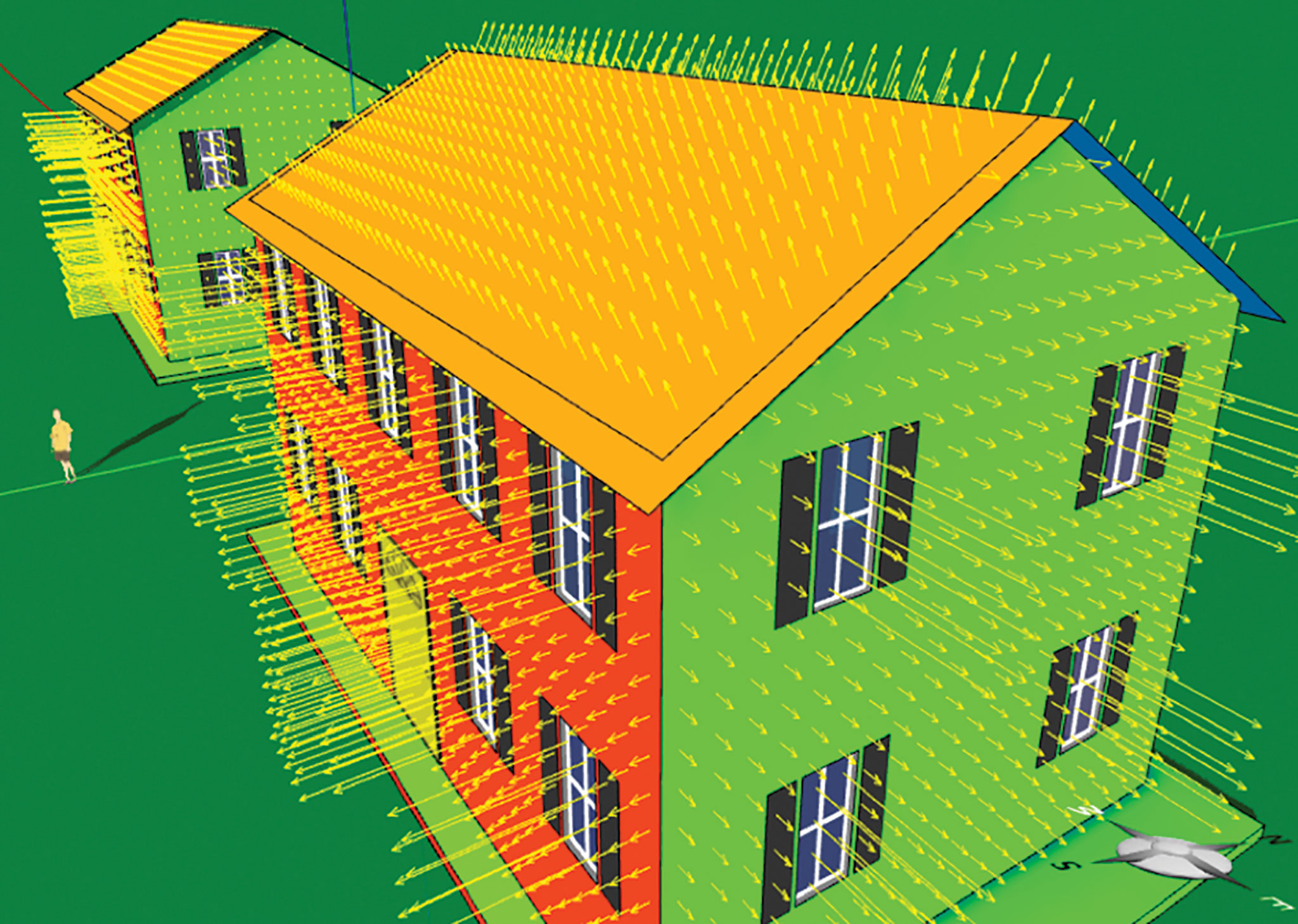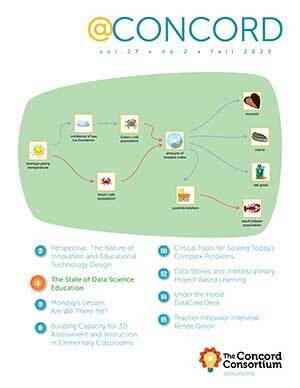Artificial Intelligence Research for Engineering Design
Imagine a high school classroom in 2030. Students are challenged to design an engineering system that meets the needs of their community. They work with advanced computer-aided design (CAD) software that leverages the power of scientific simulation, mixed reality, and cloud computing. Every cool tool needed to complete an engineering design project is seamlessly integrated into the CAD platform to streamline the learning process. But the most striking capability of the software is its ability to act like a mentor who has all the knowledge about the design project to answer questions, learns from all the successful or unsuccessful solutions ever attempted by human designers or computer agents, adapts to the needs of each student based on experience interacting with all sorts of designers, inspires students to explore creative ideas, and, most importantly, remains responsive all the time without ever running out of steam. Such an ideal mentor does not exist in humans and a robot capable of doing such a job is still in the realm of science fiction. But the rapid development in artificial intelligence (AI) in recent years is bringing this science fiction closer to reality. At last, we can see a path to it.
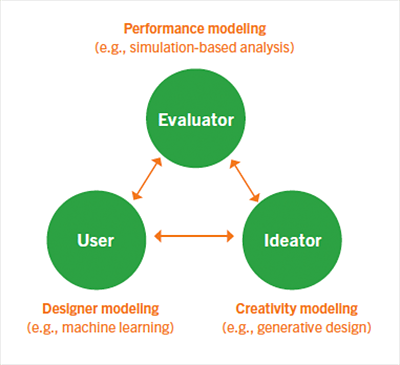
AI is one of the three most promising areas for which Bill Gates said earlier this year he would drop out of college again if he were a young student today. The victory of Google’s AlphaGo against a top human Go player in 2016 was a landmark in the history of AI. The game of Go is considered a difficult challenge because the number of legal positions on a 19×19 grid is estimated to be 2×10170, far more than the total number of atoms in the observable universe combined (1082). While AlphaGo may be only a type of weak AI that plays Go at present, scientists believe that its development will engender technologies that eventually find applications in other fields.
The challenge of engineering design
One field that excites us is engineering design. In this frontier, however, we face a much greater challenge than winning a Go game. If you are shocked by the number 2×10170, prepare to be awed. The vastness of the solution space of a complex design problem is far beyond what language can describe. To comprehend its magnitude, consider these two facts: 1) an open-ended design project is not limited to 19×19 grid points and 2) the possibilities for each point are not limited to three choices (empty, black, or white). Finding an optimal design in such a gigantic solution space is like looking for a needle in a haystack or, to put it more aptly for many engineering projects, like searching for an electron in the universe.
Given the sheer difficulty of the task, people have developed—as in the case of Go—many techniques, strategies, styles, and cultures in the practice of engineering to find satisfactory solutions that approximate optima. The development of AI based on this foundational work will eventually lead to a paradigm shift of engineering practice and education. In this article, I introduce our work as a humble step towards this grand vision.
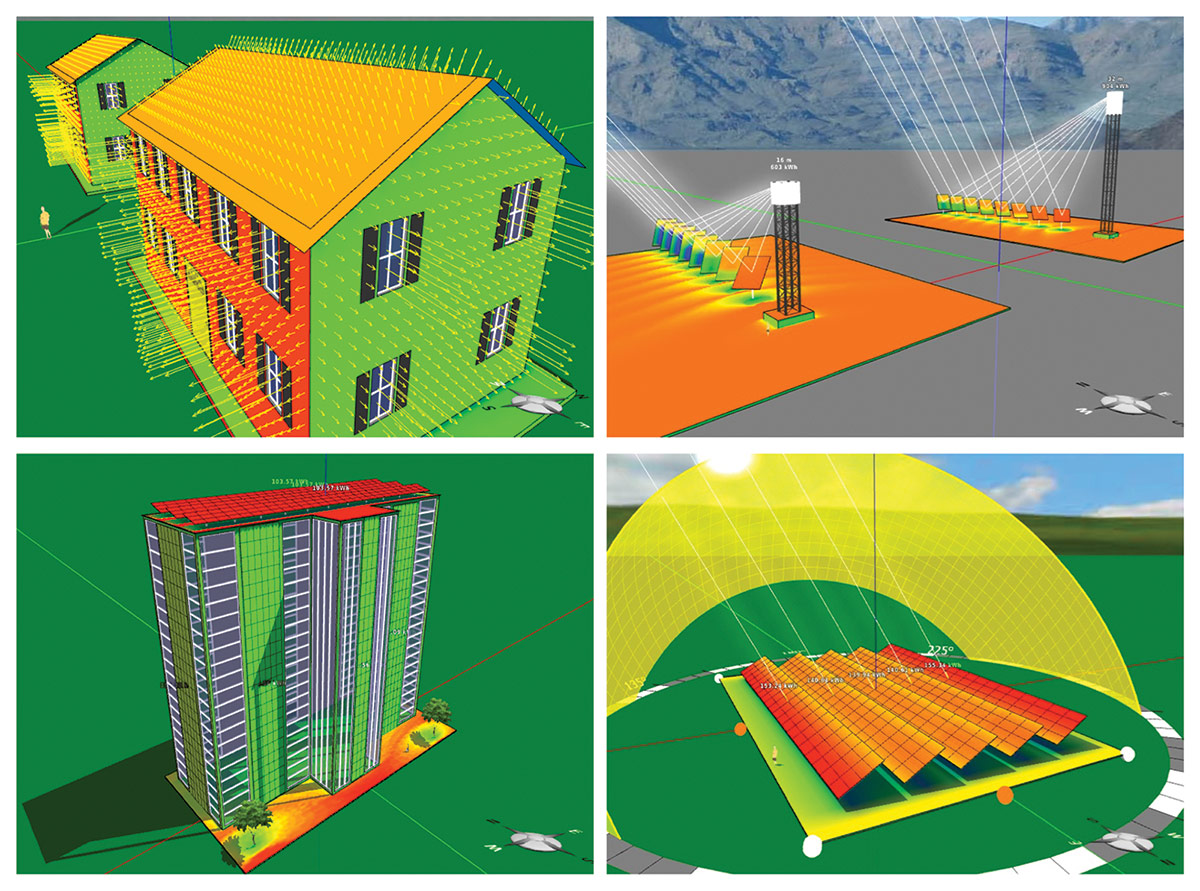
Computer-aided design and artificial intelligence
In workplaces, engineering design is supported by modern CAD tools capable of virtual prototyping—a full-cycle process to explore a product on the computer before it is actually built, demonstrated by the remarkable success in designing the Boeing 777 aircraft during 1989-1992. Here we use a more inclusive definition of CAD to encompass simulation, analysis, automation, documentation, and communication, in addition to 3D modeling typically used to represent CAD. In classrooms, CAD tools allow students to take on a design challenge without regard to the expense, hazard, or scale. They provide valuable tools for teaching and learning engineering, because a significant part of scientific reasoning and design thinking is abstract and generic, can be learned through designing computer models that work in cyberspace, and is transferable to real-world situations. Due to its pivotal importance in engineering, CAD provides an ideal platform to support the research on design AI.
The study of AI focuses on intelligent agents that perceive changes in their environments and take actions to maximize their chances of success in achieving certain goals. An intelligent agent for engineering design must demonstrate the ability to 1) mimic basic skills of a human designer for attaining a goal and 2) improve those skills through learning from new design solutions and their contributors. Computational science provides sources of intelligence for developing three types of intelligent agents (Figure 1), defined below.
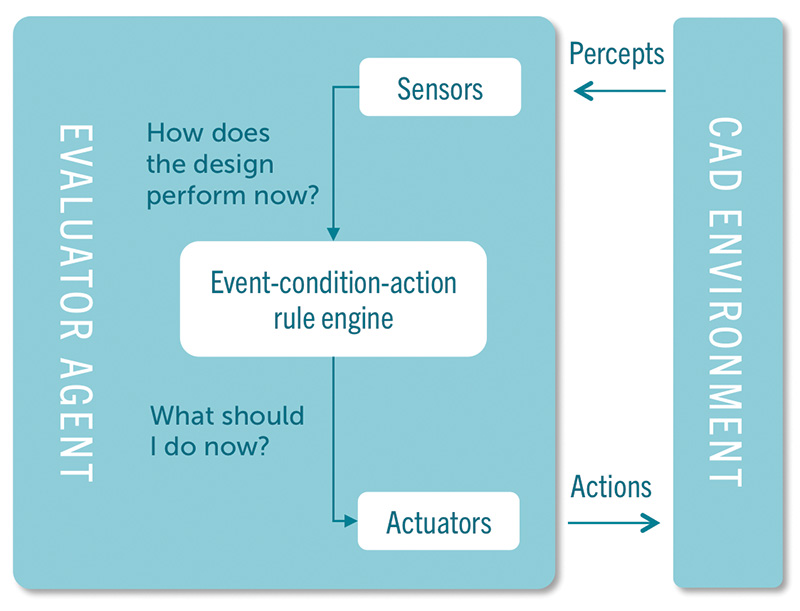
The evaluator agent
The analytical capabilities of CAD tools based on numerically solving fundamental equations in science can be used to evaluate the performance of a design artifact (Figure 2). Through a simulation-based analysis, a CAD tool can calculate and collect a variety of performance indicators that can be used as percepts for an Evaluator, an agent that simulates the role of a human instructor who provides feedback to the designer based on evaluating the design artifacts. For example, the percepts of performance for a zero-energy building under design may be the predicted net energy consumption, the total cost for constructing it, the size of the usable space in it, and so on. A more knowledgeable agent may even draw upon details such as the energy usage of each room, the electricity output of each solar panel, and the cost of each part.
The Evaluator monitors and processes percepts to generate instruction. A simple reflex evaluator is powered by an event-condition-action rule engine that triggers an action based on a rule when a condition for the rule is detected in an event (Figure 3). For instance, the Evaluator will respond with a red flag when the total construction cost of a building under design exceeds the budget limit. A shortcoming of the simple reflex evaluator is its memoryless Markov property—when the agent only takes current percepts into account to figure out its next suggestion, the result is less systematic instruction. A smarter agent to prevent a design process from degrading into the chaos of Brownian motion is the model-based reflex evaluator, driven by an internal model based on the history of percepts such as a high-order additive Markov chain model. For example, a linear trajectory of continuous improvements in building performance with the budget under control may indicate systematic optimization. A trajectory of fluctuating performance, on the other hand, suggests the possibility of a divergent-convergent loop in which the designer experiments with various ideas. When the design goals are factored into the model, the agent becomes a goal-directed evaluator that can guide the designer with a “positioning system” capable of telling how far the designer is from accomplishing the goals and whether the designer is zeroing in towards the goals or going astray.

The ideator agent
The intimidating massiveness of the open-ended design space, nevertheless, gives us hope that there is always a better solution to be found somewhere in the intellectual universe. Given the fact that an exhaustive search is unrealistic, designers need to try many ideas. The parametric and generative design capabilities of CAD tools can spur ideation by suggesting permutations and variations of design elements interactively and evolutionarily, equivalent to teaming designers up with computer co-designers capable of helping them see new possibilities. This capacity of computational design allows us to develop the Ideator, an agent for generating new designs automatically through autonomous search or semi-automatically with human intervention. By storing and sorting all the designs that have been generated in such ways, the Ideator can also learn from itself and humans to advance its knowledge base.
The user agent
The above two types of agents can be augmented by the User agent that can learn about designers by analyzing their process data. Logging capabilities can be easily added to CAD tools to collect large quantities of fine-grained process data from users in real time, the data can be mined to characterize user behavior and performance, and the results can be used to automatically compile formative feedback to students or create infographic dashboards for teachers (Figure 4).
Fostering engineering education
CAD software enhanced by the AI described above has the potential to boost designer productivity and creativity. If you are familiar with simulation-based engineering, however, you may wonder about the difference between the current approach and the AI-based approach, and the reason AI is needed to aid the design process. A challenge of engineering analysis to the designer is to make sense of the numerous data produced in a simulation and the possibilities that they represent. In a conventional CAD environment, the designer must wade through this sea of data to find clues for the next move. As in the case of playing Go, this expertise takes years of training and practice to acquire. But young students have yet to develop abstract mental models and design thinking to help them imagine and reason about engineering systems they are challenged to design. They frequently need instructional support such as formative feedback and creativity stimuli such as generative design to help them forge their mental models and shape their design thinking. These essential elements for engineering education are often insufficiently provided in real classrooms as they require tremendous efforts from teachers for individual students. When students are solving complex design problems, the workloads for teachers would escalate to such a high level that it would be impossible for teachers to guide every student through the design process. In many complicated situations, even though teachers are available, accurate evaluation of students’ subtle design decisions and effective instruction for their next steps may be possible only through computational analyses of design artifacts and designer states using the supporting CAD software. These difficult areas of design learning are exactly where AI can demonstrate its extraordinary value as a powerful teaching assistant.
Afterword
The three types of intelligent agents will be available in our Energy3D software, a CAD tool for sustainable architecture and renewable energy engineering that serves as an open research platform for design computing and engineering education. The vital subject of energy, in which Energy3D specializes, is also one of the three areas in which Bill Gates would pursue a career. If his vision heralds impending waves of innovations, our research today at the intersection of AI, energy, and engineering would turn out to be strategically important to the economy of tomorrow.
Charles Xie (qxie@concord.org) is a senior scientist at the Concord Consortium.
This material is based upon work supported by the National Science Foundation under grant DRL-1503196. Any opinions, findings, and conclusions or recommendations expressed in this material are those of the author(s) and do not necessarily reflect the views of the National Science Foundation.
